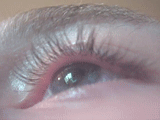
Back متلازمة الارتجاف الحزمي الحميد Arabic Síndrome de fasciculació benigne Catalan Syndrom benigních fascikulací Czech Benigne Faszikulation German Síndrome de fasciculación benigno Spanish Syndrome de fasciculations bénignes French Sindrome delle fascicolazioni benigne Italian 良性筋線維束性攣縮症 Japanese Benigne fasciculatiesyndroom Dutch Síndrome de fasciculação benigna Portuguese
| Benign fasciculation syndrome | |
|---|---|
| Other names | Fasciculation Not Otherwise Specified |
 | |
| Animated image of benign fasciculation syndrome in the upper eyelid of a 19-year-old male. Symptoms subsided several days later. | |
| Specialty | Neurology, psychiatry |
| Prognosis | Good–excellent |
Benign fasciculation syndrome (BFS) is characterized by fasciculation (twitching) of voluntary muscles in the body.[1] The twitching can occur in any voluntary muscle group but is most common in the eyelids, arms, hands, fingers, legs, and feet. The tongue can also be affected. The twitching may be occasional to continuous.[2] BFS must be distinguished from other conditions that include muscle twitches.
- ^ Blackman, Graham; Cherfi, Yasmine; Morrin, Hamilton; Ellis, Cathy M.; Bashford, James; Ruths, Florian; David, Anthony S. (September 2019). "The Association Between Benign Fasciculations and Health Anxiety: A Report of Two Cases and a Systematic Review of the Literature". Psychosomatics. 60 (5): 499–507. doi:10.1016/j.psym.2019.04.001. PMID 31174866. S2CID 146012381.
- ^ Cite error: The named reference
Walter2015was invoked but never defined (see the help page).